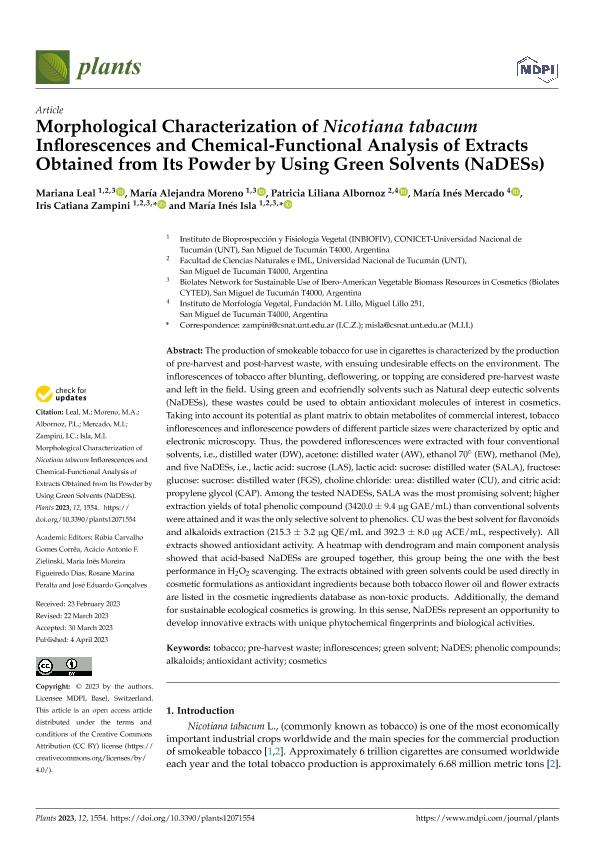Mostrar el registro sencillo del ítem
dc.contributor.author
Leal, Mariana

dc.contributor.author
Moreno, María Alejandra

dc.contributor.author
Albornoz, Patricia Liliana

dc.contributor.author
Mercado, María Inés
dc.contributor.author
Zampini, Iris Catiana

dc.contributor.author
Isla, Maria Ines

dc.date.available
2023-10-17T17:44:20Z
dc.date.issued
2023-04
dc.identifier.citation
Leal, Mariana; Moreno, María Alejandra; Albornoz, Patricia Liliana; Mercado, María Inés; Zampini, Iris Catiana; et al.; Morphological Characterization of Nicotiana tabacum Inflorescences and Chemical-Functional Analysis of Extracts Obtained from Its Powder by Using Green Solvents (NaDESs); Multidisciplinary Digital Publishing Institute; Plants; 12; 7; 4-2023; 1-19
dc.identifier.uri
http://hdl.handle.net/11336/215218
dc.description.abstract
The production of smokeable tobacco for use in cigarettes is characterized by the production of pre-harvest and post-harvest waste, with ensuing undesirable effects on the environment. The inflorescences of tobacco after blunting, deflowering, or topping are considered pre-harvest waste and left in the field. Using green and ecofriendly solvents such as Natural deep eutectic solvents (NaDESs), these wastes could be used to obtain antioxidant molecules of interest in cosmetics. Taking into account its potential as plant matrix to obtain metabolites of commercial interest, tobacco inflorescences and inflorescence powders of different particle sizes were characterized by optic and electronic microscopy. Thus, the powdered inflorescences were extracted with four conventional solvents, i.e., distilled water (DW), acetone: distilled water (AW), ethanol 70° (EW), methanol (Me), and five NaDESs, i.e., lactic acid: sucrose (LAS), lactic acid: sucrose: distilled water (SALA), fructose: glucose: sucrose: distilled water (FGS), choline chloride: urea: distilled water (CU), and citric acid: propylene glycol (CAP). Among the tested NADESs, SALA was the most promising solvent; higher extraction yields of total phenolic compound (3420.0 ± 9.4 µg GAE/mL) than conventional solvents were attained and it was the only selective solvent to phenolics. CU was the best solvent for flavonoids and alkaloids extraction (215.3 ± 3.2 µg QE/mL and 392.3 ± 8.0 µg ACE/mL, respectively). All extracts showed antioxidant activity. A heatmap with dendrogram and main component analysis showed that acid-based NaDESs are grouped together, this group being the one with the best performance in H2O2 scavenging. The extracts obtained with green solvents could be used directly in cosmetic formulations as antioxidant ingredients because both tobacco flower oil and flower extracts are listed in the cosmetic ingredients database as non-toxic products. Additionally, the demand for sustainable ecological cosmetics is growing. In this sense, NaDESs represent an opportunity to develop innovative extracts with unique phytochemical fingerprints and biological activities.
dc.format
application/pdf
dc.language.iso
eng
dc.publisher
Multidisciplinary Digital Publishing Institute
dc.rights
info:eu-repo/semantics/openAccess
dc.rights.uri
https://creativecommons.org/licenses/by/2.5/ar/
dc.subject
ALKALOIDS
dc.subject
ANTIOXIDANT ACTIVITY
dc.subject
COSMETICS
dc.subject
GREEN SOLVENT
dc.subject
INFLORESCENCES
dc.subject
NADES
dc.subject
PHENOLIC COMPOUNDS
dc.subject
PRE-HARVEST WASTE
dc.subject
TOBACCO
dc.subject.classification
Otras Ciencias Biológicas

dc.subject.classification
Ciencias Biológicas

dc.subject.classification
CIENCIAS NATURALES Y EXACTAS

dc.title
Morphological Characterization of Nicotiana tabacum Inflorescences and Chemical-Functional Analysis of Extracts Obtained from Its Powder by Using Green Solvents (NaDESs)
dc.type
info:eu-repo/semantics/article
dc.type
info:ar-repo/semantics/artículo
dc.type
info:eu-repo/semantics/publishedVersion
dc.date.updated
2023-10-12T14:55:45Z
dc.identifier.eissn
2223-7747
dc.journal.volume
12
dc.journal.number
7
dc.journal.pagination
1-19
dc.journal.pais
Suiza

dc.journal.ciudad
Basilea
dc.description.fil
Fil: Leal, Mariana. Universidad Nacional de Tucumán. Instituto de Bioprospección y Fisiología Vegetal. Consejo Nacional de Investigaciones Científicas y Técnicas. Centro Científico Tecnológico Conicet Noa Sur. Instituto de Bioprospección y Fisiología Vegetal; Argentina. Universidad Nacional de Tucumán. Facultad de Ciencias Naturales e Instituto Miguel Lillo; Argentina.
Biolates Network for Sustainable Use of Ibero-American Vegetable Biomass Resources in Cosmetics; Argentina
dc.description.fil
Fil: Moreno, María Alejandra. Universidad Nacional de Tucumán. Instituto de Bioprospección y Fisiología Vegetal. Consejo Nacional de Investigaciones Científicas y Técnicas. Centro Científico Tecnológico Conicet Noa Sur. Instituto de Bioprospección y Fisiología Vegetal; Argentina.
Biolates Network for Sustainable Use of Ibero-American Vegetable Biomass Resources in Cosmetics; Argentina
dc.description.fil
Fil: Albornoz, Patricia Liliana. Universidad Nacional de Tucumán. Facultad de Ciencias Naturales e Instituto Miguel Lillo; Argentina. Fundación Miguel Lillo; Argentina
dc.description.fil
Fil: Mercado, María Inés. Fundación Miguel Lillo; Argentina
dc.description.fil
Fil: Zampini, Iris Catiana. Universidad Nacional de Tucumán. Instituto de Bioprospección y Fisiología Vegetal. Consejo Nacional de Investigaciones Científicas y Técnicas. Centro Científico Tecnológico Conicet Noa Sur. Instituto de Bioprospección y Fisiología Vegetal; Argentina. Biolates Network For Sustainable Use Of Ibero-american Vegetable Biomass Resources In Cosmetics; Argentina. Universidad Nacional de Tucumán. Facultad de Ciencias Naturales e Instituto Miguel Lillo; Argentina
dc.description.fil
Fil: Isla, Maria Ines. Universidad Nacional de Tucumán. Instituto de Bioprospección y Fisiología Vegetal. Consejo Nacional de Investigaciones Científicas y Técnicas. Centro Científico Tecnológico Conicet Noa Sur. Instituto de Bioprospección y Fisiología Vegetal; Argentina. Biolates Network For Sustainable Use Of Ibero-american Vegetable Biomass Resources In Cosmetics; Argentina. Universidad Nacional de Tucumán. Facultad de Ciencias Naturales e Instituto Miguel Lillo; Argentina
dc.journal.title
Plants
dc.relation.alternativeid
info:eu-repo/semantics/altIdentifier/url/https://www.mdpi.com/2223-7747/12/7/1554
dc.relation.alternativeid
info:eu-repo/semantics/altIdentifier/doi/http://dx.doi.org/10.3390/plants12071554
Archivos asociados
